THE VEGGIE WHISPERER
The flavour of Durban’s best edible heirlooms
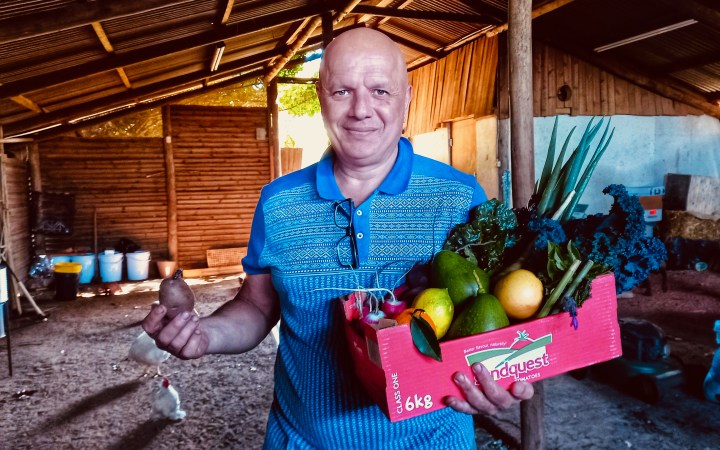
Dale Grobler gets excited about seeds and vegetables and fruits and soil and dead leaves and chicken poo. The best chefs love him. And sometimes he sits down and cries.
The author supports Food Forward SA, committed to a South Africa without hunger. Please support them here.
“Try this.” Dale Grobler plucks a glossy spinach-green leaf from a bushy little plant. “Can you taste the mushroom? After you’ve chewed it. When you swallow.” Rungia klossii, aka the mushroom plant, this is. Not something I’d heard of, which isn’t surprising given that it originated in Papua New Guinea and isn’t too common here in KZN.
“Try this. Spearmint.” Yes. No debate there.
“Try this.” He picks the prettiest vividly-pink lace-edged flower and hands it to me. “To eat?” I’ve seen these before. Perhaps once grew a few. Didn’t know them though as dianthus, one of the oldest cultivated flowers with petals that can be used in salads, sandwiches, cocktails.
“Try this. What do you think?” Accustomed to this taste game now, I bite into what he has pulled from the small tree. The skin is thickish. Should I be eating just the inside? Tartly intense, it is. “Tree tomato or tamarillo,” Grobler says, chewing on his.
“Everything on this farm is heirloom. Nothing is commercial.”
When you talk about heirloom?
“An heirloom is traditionally something that has not been modified at all. Most of the stuff we’re growing is basically just old crops. But the problem is, these crops, because they are so temperamental, hard to grow, from a commercial perspective, they’re not viable.” The beauty is, when you do grow them – and in the right soil – what you get is: flavour.
Farm to Forks, Grobler’s farm, is on the top of a tall hill with sweeping views in the Monteseel part of Hillcrest, a little over a half-hour drive from Durban. Here, on almost three acres above what is home to duiker, porcupine, wild hare, francolin, owls, crowned eagles, civets, many chameleons, he plants and experiments. Gets creative and excited about seeds and vegetables and fruits and soil and the dead leaves he rakes and the chicken poo. And sometimes sits down and cries. Like the season he lost a squash crop worth R45,000 to the pumpkin fly, an endemic bug.
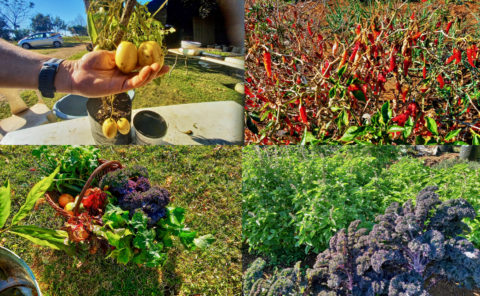
Clockwise from top left: pear melons, the last of the peppers, purple Russian kale and a winter veggie basket. (Photo: Wanda Hennig)
I tasted parsnips, carrots and kohlrabi grown by Grobler in The LivingRoom supper club’s kitchen when writing about top Durban chef, Johannes Richter. Watched Richter as he made up bottles of lemon atchar using fruit from Grobler’s trees. All of which prompted me to seek him out, go ask about his veggie magic.
“The biggest difficulty we had,” said Richter then, “besides getting staff able to work at the level we expected, was to find a steady supply of good quality produce. The backbone of our kitchen is vegetable-based and we battled for a long time. Till we found Dale; to date the monopolist of good produce here in Durban.
“Besides what we grow here, which includes all the herbs we use, he is the only real supplier of vegetables we use. And of citrus. He’s got some beautiful citrus trees. In citrus season we try and buy up whatever he can allocate to us and then make preserves and sorbets and limoncello and pickled lemons out of it. Our macadamias, too, we get from him.
“Ja, and then root vegetables… Last season we had a great harvest of organic onions that, in flavour and from a sensory point of view, were a completely different story. Basically with Dale what we’ve aimed at and wanted to focus on, is produce that grows in this very special climatic part of the world. Here, where we have a lot of humidity and a lot of heat and these dry winters. That’s the project Dale and I have now slowly started working on.”
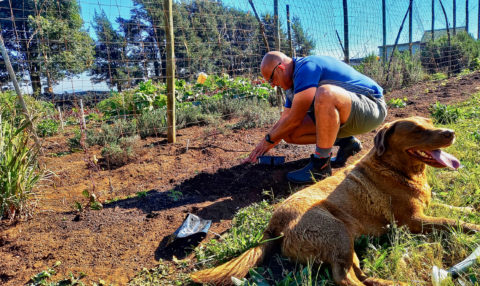
Growing tomatillos for the first time is ‘super-exciting’. With Lulu the dog. (Photo: Wanda Hennig)
“Johannes kind of designs his menu around what I can grow,” says Grobler. “What we do, with the year broken up into three month cycles – spring, summer, autumn, winter – is sit down about two months before each season starts and discuss. Then set up growing schedules and all that kind of stuff. It’s really nice from a creative perspective.”
The creative part goes further.
“Something we did for Johannes, we over-wintered about 60 metres of carrots.” Which means? “So, you grow the carrot to a specific size then during that winter, it stays in the ground and the growth cycle stalls. The starch then converts into sugars so you get a far sweeter carrot. Ostensibly the same carrot but it has a massive sugar content. What he then did was cut the carrots in half, with the fronds – everything – and used them as part of a starter menu.
“So experimenting with food like that, it’s kind of amazing. The ability to creatively grow things and potentially produce, not the usual end product, but a product that is actually far more superior in a far smaller version.”
Richter is very big on African heirlooms. So, says Grobler, he’s currently cultivating some pawpaw seeds a friend brought him from Cameroon. “And we grew some sugar beets last year – kind of a fodder guys usually use for grazing, and we pushed those really hard during winter and got the most amazing taste profiles. And we have some tiger nuts here: a groundnut that is one of the biggest staples in Africa. That (those seeds) I got from Sean (Freeman) at Living Seeds: probably the country’s biggest importer of non-GMO seeds.”
Grobler shows me the tomatillo seedlings he’s been cultivating. Now in the ground. “Also known as the Mexican husk tomato, they originated in Mexico and cultivated in the pre-Columbian era. Kinda looks like the Cape gooseberry – but very different. Excellent for salsa.”
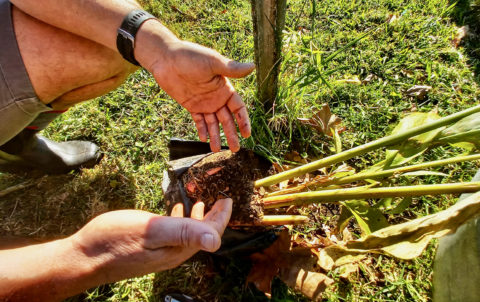
It’s taken Dale Grobler two years to get a viable galangal crop. (Photo: Wanda Hennig)
And the galangal (Thai ginger) that’s taken him two years to get a viable crop. “Sort of a turmeric and ginger mix and part of the root family. Medicinal too.”
How he got into the farming he’s doing started as a conversation with a restaurateur friend he was at school with about microgreens. “He was complaining about the quality. I said give me a couple of weeks. Grew some. Took them to him.”
As someone who cooks himself and knows a lot of chefs, it wasn’t a stretch to link up with some of them.
But Covid-19 has been tough.
“I’ve lasted three lockdowns growing super-kiff stuff. It’s ‘hard’ farming. But I don’t intend to give up.”
“Dale is an amazing farmer, he really is,” says Kayla-Ann Osborn, head chef at Delaire Graff Restaurant in Stellenbosch. “He’s just got, like, such a knack for growing things. Almost effortless. And then I kill a house plant.”
She and Grobler worked together a lot when she was head chef at Chef’s Table, Umhlanga. “Eventually we were using a lot of his products. His vegetables just taste amazing.”
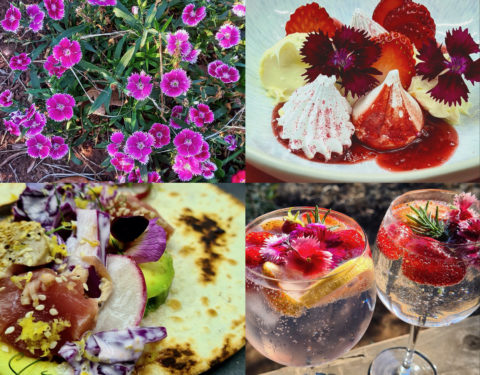
Dianthus flowers and how Dale Grobler used them: with dessert and in a gin cocktail, along with seared tuna on a soft taco. (Photo: Wanda Hennig)
“So,” says Grobler, “I’m a reasonably good cook. Not a chef (he shows me a series of pictures of a Sunday lunch, with dianthus flowers, he prepared at his farm), but I know my way around the kitchen.
“With Kayla, we’d discuss things. For instance, she wanted us to grow butternut. But only to that size.” He indicates the rough size of a walnut. “And the cool thing about butternut of that size, you can actually eat it like a fruit as you don’t get the hardening of the skin outside. And similarly her gem squash. She only wanted them this big.” (Again he indicates miniature.) “And she was using them as part of her starter menu, so you would actually eat the whole gem squash.”
He leads me among the beds past some purple Russian kale he’s been growing for Richter and points out “dune grass”. Initially foraged, with Osborn, from the Umhlanga dunes, then grown for her. “She would take bags of it weekly.”
African heirlooms, says Osborn. “Why aren’t we using those more? Why are we only growing yellow mielies? I mean, there are so many different varieties of mielies that grow well here. Original heirloom varieties. And jugo beans. It’s like somewhere between a chickpea and a peanut. They are so delicious and our third biggest crop in Africa. But we don’t eat them. And I promise you, they are one of the most delicious things I’ve ever eaten. You just boil them. They’re insane.
“So I think it’s also about looking at what we should be growing here as opposed to what we are growing here and Dale is doing that. People put rice on our menus and rice is not African.
“And I think it’s important to mention,” says Osborn – currently on maternity leave in Scottburgh with her new baby daughter – “that while there’s definitely a plant-based movement and that’s great, if you don’t know where your veggies are coming from or if they are being pesticided or grown on land that’s been destroyed, they not doing you any good.
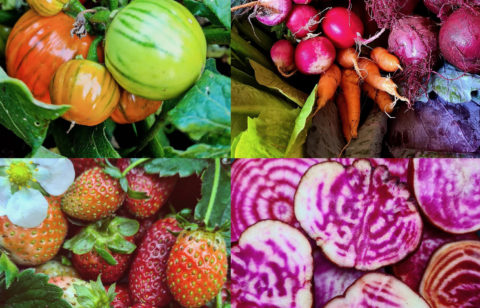
Clockwise from top left: Turkish orange eggplant, root veggie harvest, chioggia beets and sweet strawbs. (Photo: Wanda Hennig)
“You can also be putting more toxins into your body than if you’re eating meat, in my opinion. So I think, with both meat and with vegetables, it’s about knowing your farmer. Where it’s from. How it was grown and fertilised. What the soil is like.
“And also veggies should taste amazing and that’s one thing about Dale. His stuff looks amazing and it tastes amazing as well and that comes from your soil, you know. He puts a great amount of effort into his soil.”
To keep things simple, Grobler says he seldom talks to people about permaculture, biodiversity and the humus content of soil, as in the dark, organic, nutrient-rich material that forms when plants and animal matter decay. “When I got on this farm the humus content was about seven percent and we pushed up to 24%, but when you start talking about this, people have no idea what you’re talking about. So I just prefer to say our produce is non-GMO, it’s organic, we don’t use any pesticides or artificial fertilisers. And the produce talks for itself at the end of the day.”
So tell us about the compost? “I have a friend who has a chicken farm. He collects all the chicken poo for me and we use that on the farm. Down there is a concrete plinth. We get the chicken compost from him and it goes to there, sits there for about three weeks to finish its composting process and from there gets spread out.
“Then I’ve got a friend – as you can see – who does garden waste.” He points to a pile of bags. “Instead of dumping it at the dump, he dumps it here and this also naturally breaks down over a year’s cycle and it all goes into the ground. So I am a bit of a crow. I mean I’m always finding stuff.”
He mentions the park we drove past near the farm entrance. “All the leaves from the park. I rake them. Collect them. I mean, the Amazon jungle is made with that stuff. This is like gold. I get excited about leaves. Very few people do. So I mean this is full of nutrients. We break this down; use this.”
Then there are the bee hives. “One here, one down there, one on the corner of the farm. The reason we’ve got bee hives is, when you talk about fruit set, the more bees you have, the better your fruit set.
“So if you’ve got a sustainable apiary, which we’ve got on the farm, as soon as anything goes into flower, all the bees congregate and then transfer the pollen so the fruit set on the plant becomes sustainably higher. Then instead of a cluster is three or four tomatoes, what you will get is 15 or 20 tomatoes on a cluster. This means you can take off what you want to keep and discard the rest so you’re getting perfect fruit all the time.”
Where did he learn all this? “Lots of reading,” he says. “Lots of YouTube. I’ve read a substantial amount. Googling. I spend days reading. I’ll be honest with you, this is not a one-day game.
“Those trees are purely fed with chicken compost, they’re mulched throughout the whole year. And the mulch is basically, I get horse manure and horse shavings, as in the stuff that comes out of the horse stables. And the trees are mulched continuously. This cuts down on water loss and retains water in the ground and slowly bio-degrades and then provides natural nutrients to the plant root system when it rains and when that stuff decomposes.
“So it’s just organic natural fertiliser that gets created on top of the soil that then leaches into the soil that then feeds the trees. And the flavour… The taste of produce grown without chemicals and without artificial fertiliser is what they should taste like.”
Substantially different from what we buy in stores. Commercially grown, fertiliser used, artificially ripened, “picked before its ready, sprayed with gas to make it ripen over a specific period, generally stored in cold storage and then shipped across thousands of km into shops. And then that’s what you’re eating”.
What he’s growing: “What it used to taste like 100 years ago. What it should taste like.”
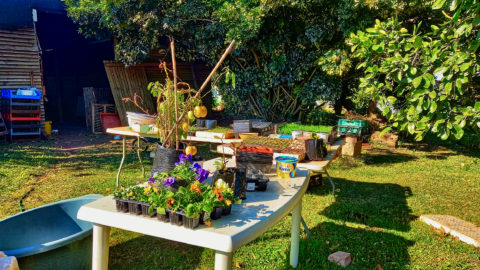
Pretty as a picture, all heirloom and hand-cultivated on this farm. (Photo: Wanda Hennig)
“For me one of the big passions is to bring back things that fundamentally, people haven’t tasted before.” Because they are among the thousands of fruits, veggies, flavours that have disappeared in the face of convenience and commercialism over the past 100 or so years.
There is a massive interest in parts of the world in what Grobler is doing. In revival. In protecting the heirlooms that remain. In bringing back what is possible of those threatened with extinction.
Click through to this link from Upworthy, which focuses through apples on things people were eating 100 years ago and won’t taste again. Because “nowadays, most seed production is controlled by big companies – and those companies patent their seeds, prohibiting things like seed saving or sharing” to quote from the article.
And this short YouTube video on seed swaps and sustainability, which gives a quick enlightening view on something Grobler does a lot of (seed swapping with like-minded grower friends) along with the development of seed banks.
Pre-Covid-19, Grobler worked with the non-profit community-focused Valley Trust organisation in the nearby Valley of 1000 Hills, teaching farmers how to harvest seeds, sow them and grow crops sustainably. He’d love to see all of us growing our own produce, eating seasonally and supporting local farmers. It’s about health. Reconnecting with the soil. And number one: flavour. DM/TGIFood
Follow Farm to Forks on Instagram and on Facebook.






 Become an Insider
Become an Insider
Those micro gems and butternuts sound amazing. Things to try.